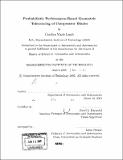| dc.contributor.advisor | David L. Darmofal. | en_US |
| dc.contributor.author | Lamb, Caroline Marie | en_US |
| dc.contributor.other | Massachusetts Institute of Technology. Dept. of Aeronautics and Astronautics. | en_US |
| dc.date.accessioned | 2006-03-29T18:46:25Z | |
| dc.date.available | 2006-03-29T18:46:25Z | |
| dc.date.copyright | 2005 | en_US |
| dc.date.issued | 2005 | en_US |
| dc.identifier.uri | http://hdl.handle.net/1721.1/32459 | |
| dc.description | Thesis (S.M.)--Massachusetts Institute of Technology, Dept. of Aeronautics and Astronautics, 2005. | en_US |
| dc.description | Includes bibliographical references (p. 79-81). | en_US |
| dc.description.abstract | The relationship between tolerances of statically measured geometric parameters and the aerodynamic performance of a sample of manufactured airfoils is investigated in this thesis. The objective is to determine which geometric parameters are the best discriminators of performance, and how these best discriminators are affected by changes in design methodology, manufacturing precision, and desired minimum performance levels. A probabilistic model of geometric variability for a three-dimensional blade is derived. Using this geometric variability model, probabilistic aerodynamic simulations are conducted to analyze the variability in aerodynamic performance. Tolerance optimization is then applied, in which allowable ranges for each geometric parameter are determined so as to maximize the quality of the accepted blades. Optimization is performed at several performance limits to observe how the effectiveness of tolerances and the best geometric discriminators of performance change with performance limit. A set of compressor blade data is used consisting of an original geometry, a deterministic re-design, and a probabilistic re-design. Using the geometric variability model, the variability is also artificially increased to investigate the impact of manufacturing precision on tolerance effectiveness. Results shows the best geometric indicators of performance are leading-edge thickness and measures pertaining to the curve quality of an airfoil. While design can affect the performance of tolerances, tolerances are no less effective on probabilistic designs than deterministic designs. | en_US |
| dc.description.abstract | (cont.) Additionally, manufacturing precision affects the best geometric indicators of performance but tolerance effectiveness is not affected. | en_US |
| dc.description.statementofresponsibility | by Caroline Marie Lamb. | en_US |
| dc.format.extent | 81 p. | en_US |
| dc.format.extent | 3630163 bytes | |
| dc.format.extent | 3633741 bytes | |
| dc.format.mimetype | application/pdf | |
| dc.format.mimetype | application/pdf | |
| dc.language.iso | eng | en_US |
| dc.publisher | Massachusetts Institute of Technology | en_US |
| dc.rights | M.I.T. theses are protected by copyright. They may be viewed from this source for any purpose, but reproduction or distribution in any format is prohibited without written permission. See provided URL for inquiries about permission. | en_US |
| dc.rights.uri | http://dspace.mit.edu/handle/1721.1/7582 | |
| dc.subject | Aeronautics and Astronautics. | en_US |
| dc.title | Probabilistic performance-based geometric tolerancing of compressor blades | en_US |
| dc.type | Thesis | en_US |
| dc.description.degree | S.M. | en_US |
| dc.contributor.department | Massachusetts Institute of Technology. Department of Aeronautics and Astronautics | |
| dc.identifier.oclc | 61751700 | en_US |
